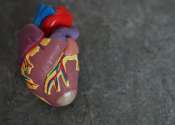Microneedle patch shows promise as a means for repairing muscle after heart attack
A team of researchers has found that applying a specially designed microneedle patch could benefit damaged heart after heart attack. In their paper published in the journal Science Advances, the group explains the related ...









